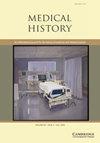Carla Bittel, Elaine Leong and Christine von Oertzen (eds.), Working with Paper: Gendered Practices in the History of Knowledge (Pittsburgh: University of Pittsburgh Press, 2019), pp. ix + 310, $55.00, hardback, ISBN: 9780822945598.
IF 1.1
2区 哲学
Q4 HEALTH CARE SCIENCES & SERVICES
引用次数: 0
Abstract
Working with Paper is a rich and engaging investigation into what is traditionally viewed as the humblest of materials, but which has immense value beyond its role as a data carrier, as this book demonstrates. Its essays examine paper practices and their intersection with constructions and negotiations of gendered power and knowledge, ranging from the sixteenth to twentieth centuries across Europe and North America. This approach encourages examination of different ‘sets of affordances given to papers’ by households, institutions and societies across time and space (5). Jacob Eyferth’s afterword reflects on the chapters’ shared themes through a study of nineteenth-century China. It emphasises the notions of paper as a ‘presence’, and paper practices as ‘socio-material processes that underlie knowledge production’ (211), rather than a ‘blankmedium that exists only to be inscribed with signs’ (209). This attentiveness to materiality, and to different social actors’ engagement with it through skill, labour and learning, is the collection’s major strength. The work is rooted in recent studies of everyday technologies, materialities and gender. However, by integrating and extending the scope of these fields, it explores how individuals and communities both reinforced and challenged societal constructions of gender through paper tools used to create and organise knowledge; ‘knowledge practices and gender relationships materialise through the making, using and handling of paper’ (12). Rejecting the ‘great man’, bookish approach to histories of knowledge, this collection focuses primarily on paper’s meanings for female identities, empowerment and oppression. Several contributions show howwomen’s paper-based skills, often related to domestic work, contribute to traditionally masculine spheres, such as science (Elaine Leong and Elizabeth Yale), academia (Matthew Daniel Eddy) and institutional or state bureaucracy (Elena Serrano, Christine von Oertzen and Dan Bouk). However, male identities are consequently approached tangentially. One important exception is Gabriella Szalay’s study of German pastor Jacob Christian Schäffer’s paper trials and their significance for competing masculinities in eighteenth-century Europe. As the volume moves beyond traditional historiographies of elite communities to the ‘uncharted waters’ of popular paperwork (2), the analytical framework of class seems equally significant as, if less explicit than, gender. Divided into twelve chapters across three thematic sections, this book is supplemented by glossy colour plates providing useful visual aids. Part 1 foregrounds the importance of paper’s material properties for the formation and navigation of social identities and relationships. Part 2 shifts the focus to paperwork as a tool for knowledge creation and management within wider social, economic and political structures, and Part 3 continues to untangle the connections between paper technologies, epistemic practices and gendered power. The volume is arranged roughly chronologically until Yale’s Chapter 9 returns to early modern England. It is perhaps best read alongside Leong’s earlier essay and creates a slightly disjointed structural effect. Additionally, some essays in the latter sections marginalise the importance of paper’s material properties in favour of the social significance of its use. This seems somewhat contrary to the introduction’s aims. However, the focus on who produces, owns, shares and values knowledge produced through paper never wavers, from Heather Wolfe’s examination of Elizabethan letter-closing techniques to Bouk’s study of twentieth-century American population research, which balances a story of female expertise against one of oppressive population control. The diverse ways in which paper practices influence, and are influenced by, knowledge of the human body emerge as a key theme of this collection. Chapter 2 is a highlight, as Leong builds on her recent study卡拉·比特尔,梁依莲和克里斯汀·冯·奥尔茨恩(编),与论文合作:知识历史上的性别实践(匹兹堡:匹兹堡大学出版社,2019),第ix + 310页,55.00美元,精装本,ISBN: 9780822945598。
本文章由计算机程序翻译,如有差异,请以英文原文为准。
求助全文
约1分钟内获得全文
求助全文
来源期刊

Medical History
医学-科学史与科学哲学
CiteScore
1.60
自引率
0.00%
发文量
25
审稿时长
>12 weeks
期刊介绍:
Medical History is a refereed journal devoted to all aspects of the history of medicine and health, with the goal of broadening and deepening the understanding of the field, in the widest sense, by historical studies of the highest quality. It is also the journal of the European Association for the History of Medicine and Health. The membership of the Editorial Board, which includes senior members of the EAHMH, reflects the commitment to the finest international standards in refereeing of submitted papers and the reviewing of books. The journal publishes in English, but welcomes submissions from scholars for whom English is not a first language; language and copy-editing assistance will be provided wherever possible.
 求助内容:
求助内容: 应助结果提醒方式:
应助结果提醒方式:


